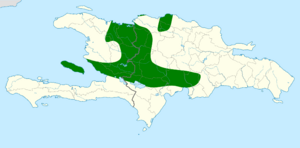Least poorwill facts for kids
Quick facts for kids Least poorwill |
|
|---|---|
| Conservation status | |
| Scientific classification | |
| Genus: |
Siphonorhis
|
| Species: |
brewsteri
|
 |
|
The least poorwill (Siphonorhis brewsteri) is a special bird that flies mostly at night. It's a type of nightjar, known for its amazing camouflage. This bird lives only on the island of Hispaniola, which is shared by the Dominican Republic and Haiti. It's the only living species in its group, Siphonorhis.
Contents
About the Least Poorwill
The least poorwill was once thought to be the same as the Jamaican poorwill. However, the Jamaican poorwill is now believed to be extinct, meaning it no longer exists. The least poorwill has two main types, called subspecies:
- S. b. brewsteri (the main type)
- S. b. gonavensis
What Does It Look Like?
The least poorwill is about 17 to 21.5 centimeters (about 7 to 8.5 inches) long. That's roughly the length of a standard pencil!
- Its upper body is grayish-brown with dark streaks, which helps it blend in with trees and rocks.
- When its wings are folded, you can see bold white spots.
- It has a wide, light brown collar around its neck.
- Its chest is dark brown with white spots.
- Its belly is white with brown stripes.
- The tail feathers have narrow pale tips. These tips are white in males and light brown in females.
- The S. b. gonavensis type is usually smaller and paler than the main type.
Where Does It Live?
The main type of least poorwill (S. b. brewsteri) is found in the central and western parts of the Dominican Republic. You can find it in areas like Pedernales, Independencia, and Barahona Provinces. It also lives in the nearby Ouest Department in Haiti. The S. b. gonavensis type lives only on Haiti's Ile de la Gonâve.
This bird likes dry or semi-dry places. It lives in woodlands with limestone, and areas with lots of cactus and thorny bushes. You might also find it in forests where trees lose their leaves, or in pine forests. It can live from sea level up to about 800 meters (about 2,600 feet) high.
Behavior and Habits
Feeding Habits
Scientists don't know much about what the least poorwill eats or how it finds food. However, they believe it mainly eats insects, just like other nightjars.
Reproduction and Life Cycle
The least poorwill is thought to lay its eggs between April and June. They don't build a fancy nest. Instead, they lay their two eggs directly on the ground.
Vocalization
The male least poorwill has a unique song. It's a whistled sound that goes "toorrrrri" and gets higher in pitch. Sometimes it makes a warbled "tworrri" sound. They also make short, whistled "toorric" or "to-ic" calls. You might even hear them make soft, scratchy sounds, a bit like a dove.
Status and Conservation
The IUCN (International Union for Conservation of Nature) keeps track of how many animals are left in the wild. They first listed the least poorwill as "Near Threatened" in 1988. This means it might become endangered in the future. In 2000, they changed it to "Data Deficient" because they didn't have enough information. But since 2007, it has been listed as "Near Threatened" again.
Experts believe there are fewer than 15,000 adult least poorwills left. Their numbers are going down. The biggest problems for these birds are:
- Habitat destruction: People are clearing the places where they live for farming or building.
- Predators: Animals like mongooses and rats, which were brought to the island by humans, hunt the poorwills.
Protecting their habitat and controlling these introduced predators are important steps to help the least poorwill survive.


